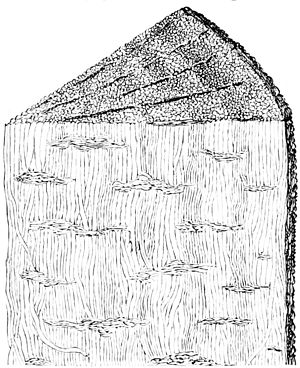ranged in concentric zones, which, if annual rings, would in some specimens indicate an age of one hundred and fifty years. There are also radiating spaces, which I was at first disposed to regard as true medullary rays, or which at least indicate a radiating arrangement of the tissue. They now seem to be spaces extending from the center toward the circumference of the stem, and to have contained bundles of tubes gathered from the general tissue and extending outward perhaps to organs or appendages on the surface. That the plant grew on land I can not doubt, from its mode of occurrence; that it was of durable and resisting character is shown by its state of preservation; and the structure of the seeds called Pachytheca, with their constant association with these trees, give countenance to the belief that they are the fruit of Nematophyton. Of the foliage or fronds of these

Fig. 4.—Nematophyton Logani (magnified) Restoration.[1]
strange plants we unfortunately know nothing. They seem, however, to realize the idea of arboreal plants having structures akin to those of thallophytes, but with seeds so large and complex that they can scarcely be regarded as mere spores.
Multitudes of markings occurring on the surfaces of the older rocks have been referred to the algæ or sea-weeds, and indeed this group has been a sort of refuge for the destitute to which paleontologists have been accustomed to refer any anomalous or inexplicable form which, while probably organic, could not be definitely referred
- ↑ Figs. 2, 3, and 4 are drawn from nature, by Professor Penhallow, of McGill College.
